The proper angle of shoots or branches is an aspect of tree training which encourages formation of flower buds and fruit, allows for sunlight to penetrate into the canopy, gives structural strength to the tree, and directs growth within the young apple tree.
Shoots or new shoots refer to current growth up to one year old. These shoots are long and vigorous, and their tip buds often remain vegetative.
Branches are older than one year and have formed new shoots and laterals. A branch can have wood of different ages.
Crotch angles and strength
Branches with narrow crotch angles are structurally weak and can easily break in the wind or from heavy crop loads.
Branches with wide crotch angles have greater connective strength and will not break because supporting wood is formed on the underside.
Effects of branch spreading
The way that shoots or branches are spread and positioned, and the time of year when this is done, affect growth and cropping.
Regardless of the growth habit of the apple variety, when shoots or branches are spread or repositioned from an upright position to a more horizontal position, terminal extension growth and apical dominance are reduced, and development of lateral branches is increased.
Spreading the entire shoot or branch in a straight line results in uniform growth along the length of the shoot or branch and creates a strong crotch angle. The closer to the horizontal a branch is spread, the more uniform are buds that develop along the branch, especially those towards the base.
Arch bending
Arch bending is where the tip of the shoot or branch is bent below some point along the shoot or branch to form an arch or curve.
This creates a different response than does straight-line spreading. Arch bending has little effect on crotch angle. At the highest point along the arch, one or more upright shoots will typically form. Other shoots are shorter in both directions from the arch.
Apical dominance
The gravitational force responses to spreading or bending are the result of a phenomenon called apical dominance.
Apical dominance regulates growth via two plant hormones. Firstly, a plant hormone called cytokinin, which is produced in root tips, moves up the tree and breaks dormancy at the highest points (tip buds) in the tree.
When the tip buds start to move, another plant hormone called auxin is produced in the actively growing shoot tip. As auxin moves down the shoot by gravity, it stops lateral buds below the tip from developing and branching.
Apical dominance is strongest in vertical shoots where auxin moves downwards and accumulates uniformly in buds, stopping them from developing lateral shoots.
The effect becomes weaker with increasing distance from the tip. As buds become more distant from the tip, they are released from the auxin influence and may develop lateral shoots.
Apical dominance varies between species and varieties, and is very strong in apple and pear.
Bending and arching affect apical dominance differently
As shoots or branches are bent away from a vertical position, auxin and cytokinin are no longer concentrated in the tip, and the number and length of lateral shoots are increased while extension growth is decreased.
If shoots or branches are arched below the horizontal, apical dominance by the bud at the tip is lost.
Auxin accumulates in the lower side of the shoot or branch, and cytokinin accumulates in the uppermost buds on the curve of the shoot or branch.
These buds, which are no longer under any apical control, develop into new upright shoots as the tree seeks to reestablish apical control in the shoot or branch.
Thus, spreading or arch bending can have a profound effect on shoot growth, which can then later affect precocity and yield.
What is a good angle?
The best production comes from branches trained to grow at about a 45-degree angle from vertical. This angle is wide enough to prevent the branch ever competing with the tree’s leader. The angle is also narrow enough to allow for the apical bud to be strong enough to impose its own apical dominance on that shoot. This allows for some continuing vegetative growth to retain the vigor of the branch, which in turn allows fruiting wood to be renewed, and optimizes fruit size and quality.
When shoots or branches are spread more than 45 degrees early in the life of the tree, strong shoot growth often develops from the upper surface of the shoot or branch.
With spreading, the tip of the shoot or branch must always be the highest point.
Avoid bending branches
When you bend a branch or shoot below the horizontal position—so that the tip is at the lowest point—the dominant bud at the highest point on the bend will develop into a strong vertical new shoot, especially when the trees are young.
These vertical new shoots should be avoided as they cannot be made into suitable fruiting wood. They can also cause crowding and shading.
Removal of these shoots in summer will not help because new shoots develop from latent buds around the pruning cuts.
If there are apples on the trees, these masses of upright shoots can adversely affect fruit calcium levels and cause storage disorders.
A pruning cut that faces up is a perpetual nightmare that can only be solved if you correct the angle above the horizontal position and restore apical dominance.
Removal of these strong upright new shoots in summer can not only lead to extensive sunburn of the apples, but also removes a large proportion of the leaf area that the young trees need for growth.
A general rule of thumb is that when you prune in summer or winter, you should see as few pruning cuts as possible when you look down onto the trees.
When should you spread?
In any tree-training system, the aim is to fill the tree’s space as quickly as possible. This means you must encourage as much growth as possible in the first and second years. Spreading shoots or branches before they have filled their allotted spaces will ultimately delay the time when trees should be in full production.
The best time to spread is in August and September (February and March in the Southern Hemisphere), when growth slows down, but there is still enough sap flow to facilitate spreading and encourage strong structural development.
You can spread in winter, but the shoot or branch may not spread as well as when you do it in late summer or in spring before flowering.
A few hints
Before spreading branches with narrow crotch angles, undercut them first. With a pruning saw that has fine teeth, make three cuts under the branch where it joins the leader. Space the cuts out about half an inch (13 millimeters) apart, and cut about halfway into the branch. The leader is the main part of the tree’s frame and is situated directly above the root system.
Shoots and branches that you spread must obey the 3-to-1 rule, which refers to the relative sizes of the shoot or branch and the leader. A shoot or branch must have a diameter of one-third or less of the diameter of the leader where it joins the leader. The 3-to-1 rule ensures that a dominant leader with a balanced structure of branches develops.
Make sure that you always work with dominant leaders that are progressively tapered to the tops before you start spreading the shoots or branches. Spreading from the base up keeps the tree calm and in balance.
Tatura Trellis or Open Tatura
In a Tatura Trellis or Open Tatura, space the bottom and second wire 12 inches (300 mm) apart in order to establish the basal framework easily. All other wires can be spaced about 16 inches (400 mm) apart.
To avoid choking the leader, select branches that are not directly opposite each other.
The grower who adopts the practice of spreading, not bending, shoots and branches of young apple trees is taking the most important step in developing a productive orchard. •
Bas van den Ende is a tree fruit consultant in Australia’s Goulburn Valley.

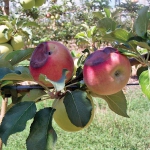
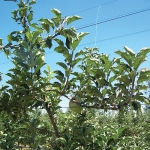
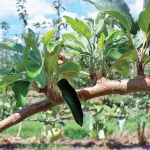
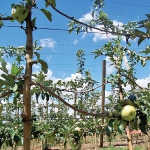
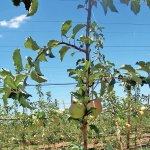
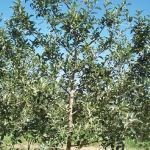





Mr. Das van den Ende, this is the best article on spreading limbs that I have read. Well organized, explains the science behind the methods and results, supports information with pictures. Well done!
The man is the best teacher in the methodology of fruit tree pruning I know of, and I’ve been reading his articles for a couple decades from various publications along with a lot of material from other fruit tree gurus to compare him to.
Thank you for excellent detailed advice.
I have a couple of so called “urban” or “columnar” apple trees 5-6 years old. One once produced several excellent apples and then stopped completely. Both are not even bloom for last three springs. They are otherwise healthy and grow fast. Does it make sense to try to spread branches of columnar apples?
I’m living in Silver Spring MD, USA zone 7a.
Thank you.
Thanks…I ve learnt much in the above article on bending young apple tree
Hello Bas
Thanks for the above article. Someone came to me here in Africa with a unmanaged orchard and with the question how to get it into production. I would like to pull lines from tree to tree and tie the vertical branches to make them horizontal, followed by a defoliation to make the tree think it comes out of the dormancy. Would that make any sence?
Thanks,
Erik van Rees Vellinga
Kenya